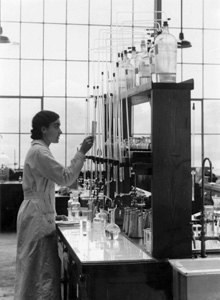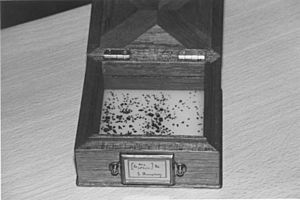Edith Humphrey facts for kids
Quick facts for kids
Edith Ellen Humphrey
|
|
|---|---|

Edith Humphrey in her laboratory.
|
|
| Born | September 11, 1875 |
| Died | February 25, 1978 (aged 102) |
| Nationality | British |
| Education | Bedford College |
Edith Ellen Humphrey (born September 11, 1875 – died February 25, 1978) was a smart British chemist. She did amazing new work in a field called co-ordination chemistry. This was at the University of Zurich with a famous scientist named Alfred Werner. Many people believe she was the first British woman to earn a doctorate (a very high degree) in chemistry.
To celebrate the 150th birthday of the Royal Society of Chemistry (RSC) in 1991, some of the special crystals Edith made for her PhD were sent to them. These crystals are still on display at the RSC today.
Contents
About Edith Humphrey
Her Early Life and Schooling
Edith Humphrey was the youngest of seven children. Her father, John Charles Humphrey, worked for the city of London. Her mother, Louisa, was a teacher. Even though her father came from a poor family, he strongly believed that all his children, including his daughters, should get a good education.
Edith grew up in Kentish Town, London. Her older sisters became teachers. Her brothers, like Herbert Alfred Humphrey, who invented a special pump, also went to college.
Edith went to Camden School for Girls. Then, in 1891, she attended North London Collegiate School. This was one of the first schools in the UK to teach science to girls.
From 1893 to 1897, Edith studied chemistry and physics at Bedford College, London. She even won a scholarship to help pay for her studies. After finishing her degree, she decided to apply for a PhD at the University of Zurich.
Becoming a Doctor of Chemistry
On October 17, 1898, Edith started her chemistry studies at the University of Zurich. She joined many other students working with Alfred Werner. Their lab was in old cellars, which they called the "Katakomben" (catacombs).
Studying in Switzerland was expensive. Edith received a grant, but she was still "hard up" (didn't have much money). Professor Werner saw how talented she was. He hired her as his assistant, which meant she earned a salary. Edith worked very hard. She later said that the social life there was not very exciting.
Edith was the first of Werner's students to successfully create new types of cobalt compounds. These compounds were very important for Werner's ideas about how chemicals connect. One of the compounds she made was the first "chiral" octahedral cobalt complex. Chiral means it's like your hands – a mirror image that can't be perfectly placed on top of the original.
In 1991, Edith's special crystals were given to the Royal Society of Chemistry. They are now kept in Burlington House, London.
It's a shame that Edith's amazing discovery wasn't fully recognized at the time. Her work helped prove Werner's ideas, which later won him a Nobel Prize. Even though some later studies questioned the quality of her sample, Edith is still seen as a very important woman scientist who broke new ground.
In 1901, the University of Zurich accepted her doctoral paper. It was about how metals bond in compounds. Edith was the first British woman to get a chemistry doctorate. However, she wasn't the first woman to get one in Zurich. An American chemist, Rachel Holloway Lloyd, had done so in 1887. Zurich was a welcoming place for women students from all over Europe.
After finishing her PhD, Edith was told to go to Leipzig University to continue her research. But the way women were treated there was very different from Zurich. She wasn't allowed to work in the labs because they thought her presence would distract the men. Edith would not accept this rule.
Her Life After Zurich
After returning to England, Edith started working for Arthur Sanderson & Sons. This company made fabrics and wallpaper. She worked there as a research chemist at their factory in Chiswick until she retired. We don't know much about her specific work there. In the 1911 census, she simply listed her job as "chemist."
In 1904, Edith was one of 19 women chemists who asked the Chemical Society to allow women to become members. This finally happened in 1919. Edith was then elected as a fellow (a member) of the society.
On her 100th birthday, September 11, 1975, an interview with Edith about her time in Zurich was published in the New Scientist magazine.
See also
 In Spanish: Edith Humphrey para niños
In Spanish: Edith Humphrey para niños


